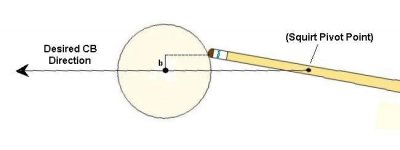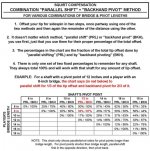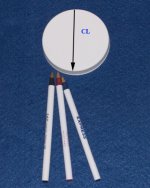Hu, I guess it's a truism, but it depends on what one means by slight. The diagram shows how the cue must be oriented for an intended cueball direction and tip offset (b). Note that the cue's intrinsic pivot point lies along a line going through the center of the cueball in the desired direction.For all of those that think the stroke angle is the same, as usual we can exaggerate things and make them clearer. Grab a large ball, volley ball sized or bigger, and lay it on the floor or a pool table if you have one at home.
Lay a cue stick pointing at it dead center, representing a standard centerline shot. Now grab the stick one foot from the tip and hold it in place as the bridge for back hand english. Grab the middle of the wrap area and swing the cue stick until the tip points at the halfway point between center ball and the edge. This illustrates backhand english. Note that line and return to the center ball line.
This time grip the cue in the middle of the wrap area and holding this in place, swing the cue tip to the same halfway point on the cue ball. Note this line, this represents front hand english. Return the cue to the original center ball location.
Now move both the bridge and the grip hand in the same direction to move the tip to the same point halfway between the center line of the cue ball and the edge. This represents parallel english.
By using the large ball anyone should be able to see that we are looking at three distinct angles. If you can't resist poking that big ball with a cue stick you will find that only slight adjustments to the contact point are required to send the ball to the same location using any of these three angles.
Hu

Patrick has been saying that no matter what method you use to arrive at this orientation, that's the way the cue has to be positioned for this particular offset (b) and cueball direction. (Forgive me, but I'm not sure at this point if you're in total agreement with this.)
Call the distance from the tip to the cue's intrinsic (squirt) pivot point "P," and the distance from the tip to your bridge "B." Here are three systematic ways of producing that orientation.
Backhand English - Simply bridge at the intrinsic pivot point (B=P).
Parallel Shift with a Bridge Pivot - Here you're pivoting at your bridge, which happens not to be located at the squirt pivot point (B not = P). Starting with your cue lined up at centerball along the desired CB direction, first parallel shift by the distance (1 - B/P)b, then pivot to take up the remainder of the offset (B/P)b. For instance, if P is twice B, parallel shift for half of b and then pivot the rest of the way. If P lies between your bridge and the tip (B>P), then the quantity (1-B/P)b is negative. In that case, parallel shift in the opposite direction (away from b) by that amount, then pivot at your bridge to b.
Parallel Shift with a Grip Pivot - The above formula is general, so just replace B with G, where G is the distance from the tip to your grip hand. Since G will always be greater than P, the parallel shift will always be "negative" (i.e., away from b).
I'm not necessarily recommending anyone do the above (especially since no one may have actually read through it
Jim
Last edited:

